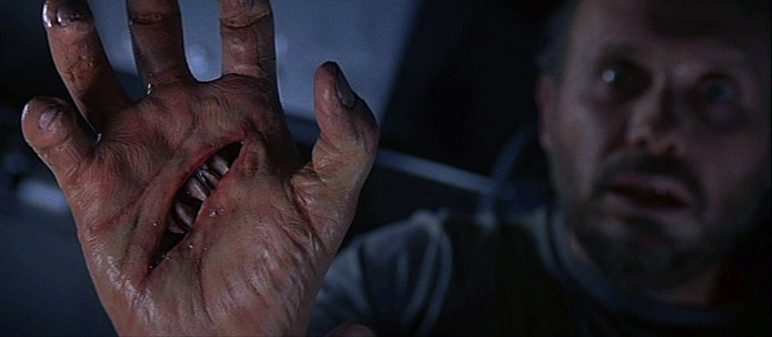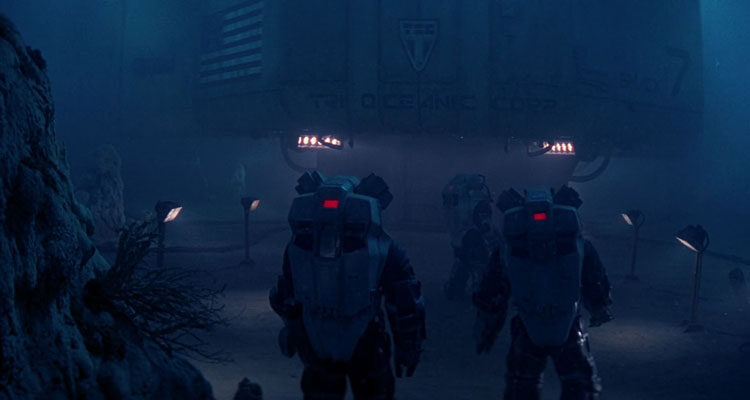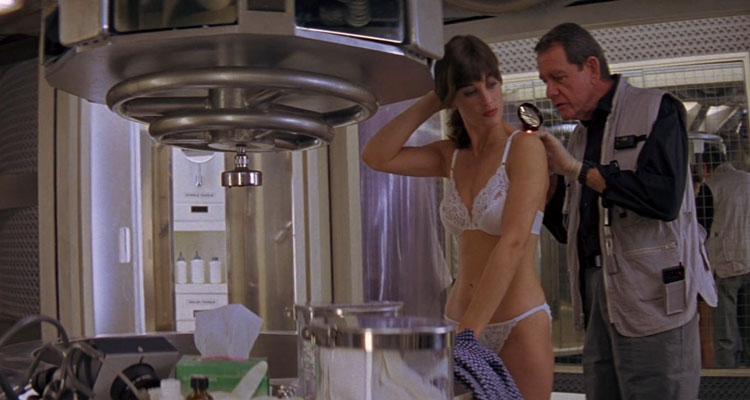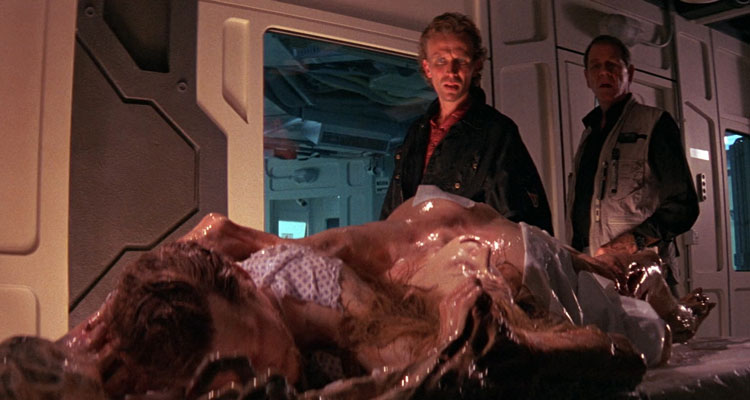

“An organism of unknown origin. No kidding.”
There were several underwater horror films released in 1989 that took the Alien formula and used it to explore the murky depths of the ocean rather than outer space. The most artful and lasting of these is James Cameron’s The Abyss. Less enduring is George P. Cosmatos’s Leviathan, which boasts a nice roster of fringe actors and practical special effects from legend Stan Winston. The story involves an underwater mining crew discovering an abandoned Russian vessel, which contains a bottle of vodka, discretely passed around by the crew, that is permeated by traces of an experimental drug that transforms people into hideous beasts reminiscent of The Thing. It’s an unashamed assortment of clichés/homages, with inevitable plotting and plenty of logical gaps, but I found it to be a very enjoyable B movie. Certainly lesser than the films that inspired it, and clearly a tier below The Abyss as well—but it serves its purpose as a derivative entry in the genre and does not commit any grave errors. It hits all the right plot beats, gradually claims its victims, and knows when to lighten the mood with the insertion of a cheesy one-liner. A lot of fun if you’re not asking too much.
We’re situated in the underwater rig, made aware of the precariousness and persistent danger of the operation, and introduced to the team of miners—Beck (Peter Weller), Doc (Richard Crenna), Willie (Amanda Pays), Sixpack (Daniel Stern), Jones (Ernie Hudson), DeJesus (Michael Carmine), Bowman (Lisa Eilbacher), and Cobb (Héctor Elizondo). Some of these we barely get to know before they’re consumed by the fearsome creature that emerges from their insides. Prior to the threat becoming evident, those who drank from the forbidden bottle of vodka begin exhibiting odd symptoms that do not raise alarms. Sixpack feels sick and Doc discovers lesions on his back; Bowman’s hair begins falling out. The former dies in the medical ward shortly after falling ill, but Doc and Beck choose to keep that information to themselves to prevent panic. The pair review the Russian captain’s video log and discover that similar medical problems ravaged their crew and they scuttled their ship intentionally in an effort to prevent the monstrosity from propagating. They find Bowman dead by her own hand in one of the showers and request emergency evacuation but are informed by the company’s CEO (Meg Foster) that a storm on the surface precludes it.

This first act is promising. The characters are given distinction by a cast of memorable supporting actors. Weller was a familiar face, if not a star, after the success of Robocop; Richard Crenna had a supporting role in the Rambo films; Daniel Stern will be immediately recognizable to anyone who’s seen Home Alone (although Leviathan came out first); and Ernie Johnson had a prominent role in Ghostbusters. There’s a meager attempt at giving a few of the characters a second dimension and developing relationships between them, but once things go all cattywampus these threads are mostly dropped in favor of squirmy tentacles, unidentifiable appendages, gory deaths, flamethrowers and chainsaws. A modicum of tension stems from the claustrophobic setting and the impersonal decision by the Tri-Oceanic Corp to leave the crew stranded underwater with the monster because they are concerned primarily with profit and see their crew as expendable. However, even when the dramatic tension is lost and the visceral excitement takes over, Leviathan avoids becoming a cheesy romp. The cast, script, direction, and creature effects pass the sniff test, and Jerry Goldsmith’s score of whale song gives the proceedings a creative tonal flourish. The only thing that doesn’t carry its weight is the occasionally clumsy action sequences which are hampered by awkward combat and cheap-looking weapons.

Stan Winston acts as the connective tissue between Leviathan and its predecessors. Winston had been second-unit director on Aliens and worked on the creature in The Thing, and his sensibilities are etched into the DNA of Leviathan. He’d only turned down work on Cameron’s The Abyss because Cameron was notoriously demanding and Winston wanted to try his hand at directing his own film (Pumpkinhead) and so accepted a few gigs that would require less taxing involvement. And it seems that many members of the cast and crew viewed Leviathan that way, as a paying job more than a work of art, although the assembled talent going through the motions can’t help but instill it with some flair. Unfortunately, whether it be due to the recycled nature of Winston’s work, budget constraints, considering the mystery scarier than the revelation—the fully formed creature is only shown in brief blink-and-you-miss-it shots. But the earlier appearances of the beast, which feature smaller creatures, are suitably gross and animated very well. They work much better than the lumbering amalgamation of deep sea marine life that is seldom shown for more than a second, and the instances where the assimilated human faces cry out for help is the stuff of nightmares.
Whereas the creation of The Abyss is perhaps more interesting than the film itself, with its underwater shoots, brushes with death, and tense crew relations, Leviathan was shot entirely above ground. There are several “underwater” shots achieved by creative lighting effects that had me completely fooled. In some cases, the authentic shoot of The Abyss gives it a definite edge, but Leviathan does a fine job of conveying the setting without the massive budget of Cameron’s production. Even if it’s not the technical achievement of The Abyss, the set design mostly works. There’s occasionally a moment or two where it feels counterfeit, but for the most part the rig passes as a functioning operation with leaking pipes, metallic creaks, and cluttered living quarters.

I’m not exactly sure why so many underwater horror films were released in close proximity. DeepStar Six, The Evil Below, Lords of the Deep, and Endless Descent all came out right on top of one another. Maybe it was the repeatedly delayed release of The Abyss, maybe it was the discovery of the wreckage of the Titanic in 1985. Whatever the cause of the little trend, most of the films were flops—even Cameron’s didn’t get the commercial action that was expected. Aside from its unoriginality, many criticized Leviathan for its weak ending. I’m conflicted on the issue, because while it is dramatically weak, it also features two splendid moments that can only appear in a B movie. Once the survivors break the surface of the ocean, the monster hot on their trail, Peter Weller commands the mutated beast to “Say ‘ah’ motherfucker” and then lobs a pipe bomb into its maw. Once they are safely on board the Tri-Oceanic oil rig, Meg Foster’s CEO character approaches them with a fake smile and fake concern for their well being. When she asks how Beck is feeling, he punches her in the face and says, “Better. A lot better.” Cut to credits.
Even though it’s derivative, it exists in the shadows of Cameron’s film, and it suffers from a poor implementation of its monster, Leviathan is simply a very fun movie to watch. After all, we’ve got Robocop, one of the Wet Bandits, a Ghostbuster, Colonel Samuel Trautman. It can’t avoid comparisons to the movies it openly imitates, and it doesn’t come close to them in terms of artistry, but as a relic of the 1980s B movie aesthetics, it is a blast. I don’t care that there’s not an original bone in its body.